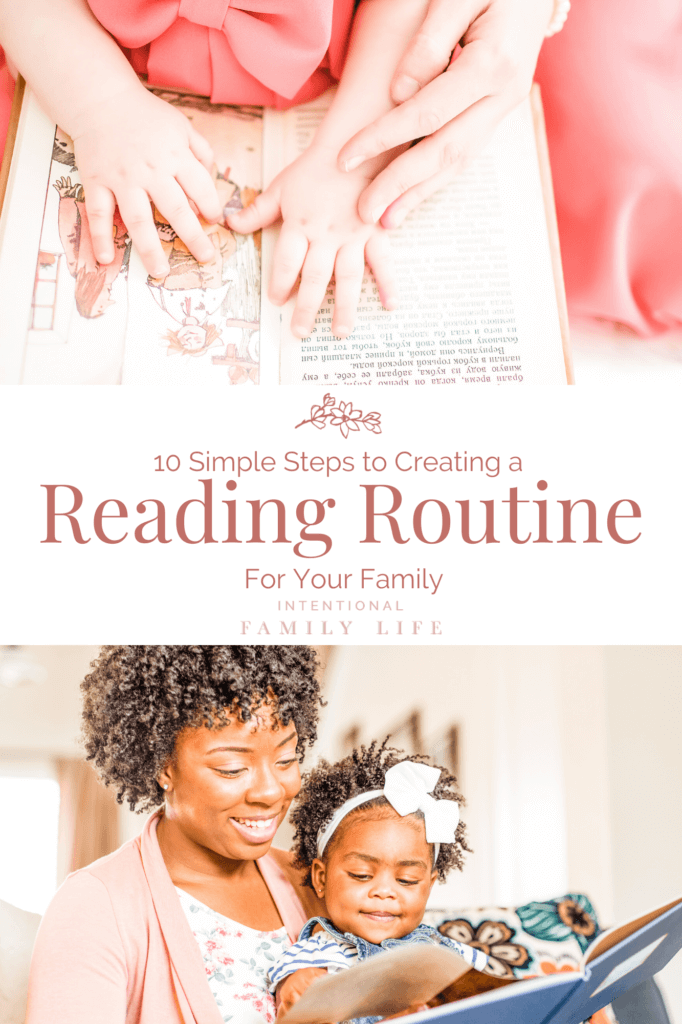You’re definitely in the right place if you love to read and you want to develop a good reading habit in your family. Reading habits or routines can be thoughtfully and intentionally developed and there are so many benefits to nurturing a culture of reading, that it’s really a no-brainer.

If your kids are like mine, they relish living in a culture awash in television, tablets, and video games. Seriously, at any given moment from when they wake up to when they go to bed, they’d love to be on any kind of screen.
And, although a screen could keep them occupied, like a lot of people, I don’t want my kids spending that much time on screens.
What are we missing out on when too much time is spent on screens?
Family games? Yep.
Family read alouds? Probably.
And much, much more.
With all the screens and tech overtaking our kids, the pleasure and deep satisfaction of family reading has fallen by the wayside.
The evidence is clear that reading is not only important for academics, but for social skills and development as well as family bonding. In short, reading:
- Allows kids to love stories and then fall in love with reading books.
- Provides an opportunity for you to bond with your child.
- Awakens a child’s curiosity, imagination and critical thinking skills.
- Exposes you and your kids to new worlds, new people, new cultures, new ideas, and new places.
- Provides a deeply satisfying escape from the pressures adults and children are up against every day.
So, what can we do to create a reading culture at home when the world is so filled with distractions? Here are some tips that really work!
Always Read To Your Kids
You can never start too early.
The benefits of reading aloud actually come from your voice – long before your baby begins to learn to read. Babies don’t understand the words yet, but it’s mother’s voice, as you read, that benefits newborn babies.
Your reading helps their brain development more than you realize way before they start reading!
A mother’s voice can soothe a child in stressful situations, reducing levels of cortisol, the stress hormone, and increasing levels of oxytocin, the social bonding hormone. Scientists have even traced the power of a mother’s voice to infants’ brains: a mother’s voice activates the anterior prefrontal cortex and the left posterior temporal region more strongly than an unfamiliar voice, priming the infant for the specialized task of speech processing. (Mother’s voice shapes baby’s brain development)
I had one son who had an overwhelming ability to listen to stories for long periods of time. He loved listening to The Lorax (Classic Seuss) at six months old. Sat through the whole thing. (ok, maybe he laid down a bit…)
My second son also enjoyed reading time, but with a more typical attention span of about two to four minutes. Truth be told, I think he preferred chewing the book over listening to the book.
Whatever. He enjoyed reading time!
Since I had one book loving baby and one baby whose motivation for loving the books was questionable, I put together a list for you of our favorite board books for babies that were hits with both of my boys! It’s a tried and true list and something on there is guaranteed to work for you!
Always Make Books Available For Your Kids – No Matter How Tiny They Are
Babies experience the world through touch and often through mouthing objects that they wish to explore. (Refer back to my book-eating son.)
Since I always wanted my boys to be curious about books, even in that early mouthing stage, I always had soft non-toxic baby books available where baby could reach them. Now, you can even find sweet fabric baby books that are interactive!
My boys had a bookcase in their nursery and the bottom shelves were always loaded with board books that they could mouth, bonk, and toss as well as the soft baby books. I wanted nothing more than for them to love to read.
We even took our reading to the “high seas!” Did you know that there are books that were made for the tub! Sandra Boynton was a family favorite – both in the tub and out! I’ve found now that they even have a bath version of The Rainbow Fish!
And as kids grow up, it becomes easier to always have books available to nurture reading habits. At any age, let your kids have access to books anywhere they are.
Make Trips To Your Local Library
People who love to read find their people in libraries.
Most, if not all, local libraries have set story times for preschool children. And don’t worry – the littlest ones will be encouraged to move and groove! No sitting silently still for boring stories during story hour!
Many libraries hold special programs for elementary age children or have a book club perfectly suited to your child’s age group.
As your children become elementary age, introduce them to the librarian. Librarians love to help children find the perfect book and they enjoy watching children develop a life-long reading habit!
Cultivate a relationship with your librarian and she will quickly come to anticipate what books your child will love. By the time my boys turned about five, they each got a library card. Not only can children this age pick out a good book, but they will be learning the responsibility of keeping up with that book until it is returned.
Create Daily Reading Habits
Make reading a tradition in your home. Set a specific time each day where everyone begs to hear what will happen next.
You can choose to have your kids read on their own, or if you want to make it even better, choose a story to read to your kids. Stick with a regular reading schedule. Establishing this tradition makes kids look forward to this time of reading as a family.
And, let’s face it. We’re all busy. So if this idea seems daunting, you can set a goal – whether it’s 20 minutes or 30 minutes – just have a goal. You can even start with five minutes a day! We can always find five or ten minutes. Before you know it, that time will stretch into longer and longer reading periods as your kids become engrossed in stories and develop reading and listening stamina.

Model Your Own Love of Reading
How many times have you heard it; kids will do what they see not what you say?
If you want your kids to read, you have to let them witness your own reading habits. Make sure you talk to your kids about a new favorite book you are reading, talk about the characters, and why you are excited to read it.
Model what reading looks like, so they will follow your lead.
One fun idea is to carry a book with you wherever you go (even if it’s on a Kindle). Don’t discount those couple of minutes while you wait in line. If your child is on edge, having a story to read just may save the day!
Use All Your Senses to Cultivate a Passion for Reading
Reading is great, but you can make reading even more fun by experiencing them with all of your senses!
Let the kids feel what it likes to be one of the characters in the story; act out the stories! Read a book then have your kids pick a character in the book and act it out. You could also try puppet shows that go along with the story. You can look for crafts or activities that go with your story.
Find and make a recipe that goes with the story; let them smell and taste what’s behind the story. Get creative and have fun with the story, the characters, and reading!
Another of our favorite ways to experience reading is to listen to stories with Audible! If you try audible now, audible will give you two free books! I love audible because there are times when I, too, want to listen to a story!
Embrace All Forms of Story Telling
Making up stories is just as valuable as reading stories. Kids love to actively be a part of the story-telling. Storytelling develops creativity, critical thinking, and imagination.
My favorite way to incorporate the kids into my storytelling is to ask each boy for three things that they want to hear a story about. One may say, “a dragon, a tow truck, and a pencil sharpener.” The other may say, “a sword, a video game, and a cup of coffee.” I then have six random things to incorporate into a story.
These stories are so much fun and they’re different every time!
We also love the game where we go around the table and each one of us adds one sentence to the story. We actually enjoy playing this game in the car. If you have trouble getting it started, try using creative story games.
Books are simply stories that you take in via the written word. But don’t forget that historically, stories were also shared and passed on through the spoken word.
Share Your Personal Reading Habit
If you can afford it, buy books for your kids. I always tell my kids books are the only thing I will hardly ever say, “no” to. They always get books as gifts as rewards, for holidays, and for birthdays.
This way, they see us spending money on books as well as sharing and giving books. In this, they see that books are something we place great value on.
Read to Answer Questions
Another way to create a reading habit is reading for answers. When you love to read, referring to trusted books is almost automatic.
But what about Google, you ask? Google is faster. Google is easier. Well, maybe.
But here’s the thing. I’ve always believed that worthwhile things in life are more about the journey than the end result. And I have never opened a book to answer a question without finding something even more interesting than what I was originally looking for.
So, whenever your child asks you a question, look it up and read about it. For example if she asks “why do fish live in the water,” don’t just give her a basic answer, look it up and read about it together. Then look for stories, non-fiction, and poetry about fish. And starfish. And squids.
Questions About The Ocean: 25+ Outstanding Children’s Books That Will Inspire A Love Of the Ocean
Follow that rabbit trail wherever it leads your child! Showing kids this way to use books not only fosters a love of reading, but encourages independence when seeking an answer to a question.
More Books To Answer Questions: 5 Picture Books About The Summer Solstice & Its Traditions
Create Fun Family Traditions That Nurture Positive Reading Habits
My favorite tradition that reinforces our family reading habit, is purchasing books as souvenirs. When we take a family trip, we always look for a nearby independent bookstore to spend an afternoon. We adore E. Shaver Booksellers in Savannah, GA. I would seriously live there if they’d let me. But you can start any number of traditions.
- select 100 books you want to read as a family
- let each family member make a reading list and then go to the library each week
- make a “books this year” list for each family member or for the family as a whole
- have an end of the week performance of a scene from a story you read during the week
- choose books to read aloud
- once a month (or two) select a book to read and then watch the movie version
- have a “book club” with each of your kids
How do you create a reading culture in your home? Share your tips in the comments below!
Don’t Forget To Pin This Post For Later!





